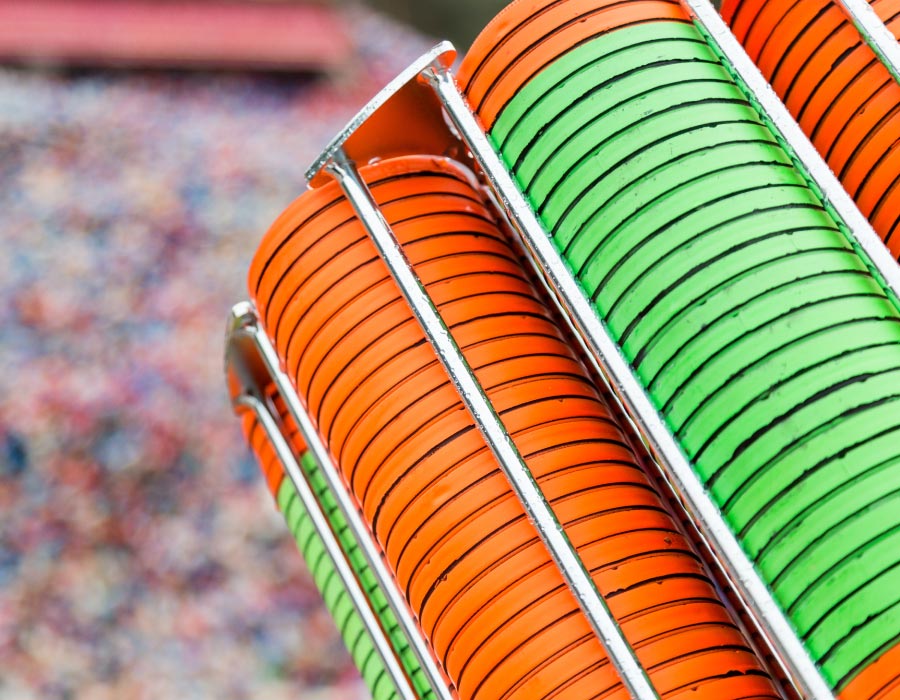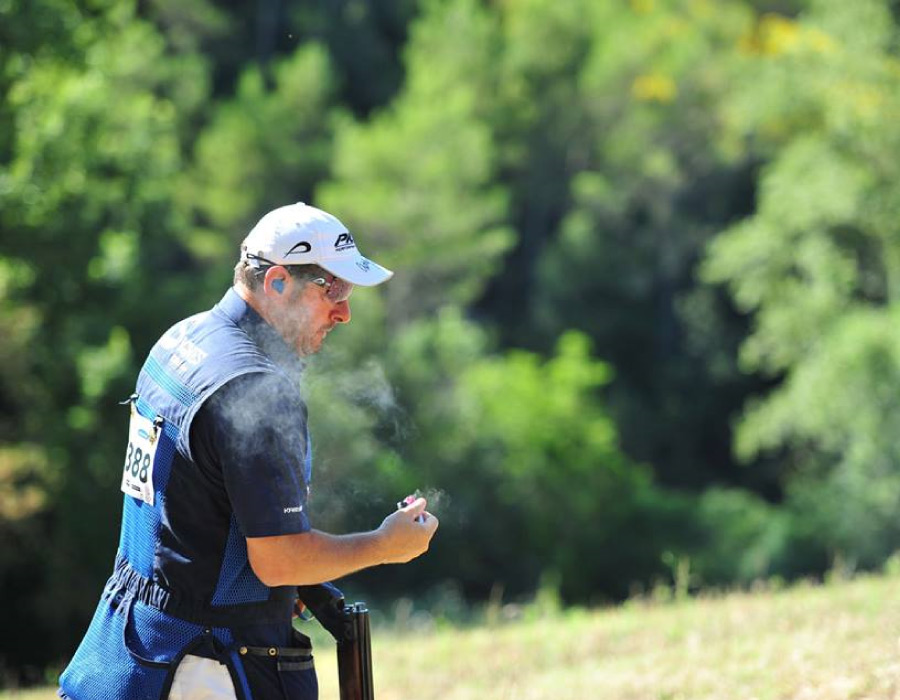After the second half of the nineteenth century, hunters were amused by aiming for objects thrown into the air, to test their reflexes. This pastime immediately became popular, especially in America, so much so that at the end of the nineteenth century the first moving clay targets began to be found on the market. The chosen form: a disk. In England they were called clay-birds and in France clay pigeon, referring precisely to birds. Over time, the targets were renamed clay pigeons, and the history of clay pigeon shooting began.
With the growth of supporters, the activity began developing until 1900, when, at the second Olympics of the modern era, in Paris, the Trap discipline, also called Fossa Olimpica, was entered for the first time in the competition, even if allowed only as an optional sport. Trap became a great success.
Crazy about shooting, the adventure begins with Trap
Trapshooting is characterised by different specialities: as already described in this blog post. However, Trap is certainly one of the most practised. To get started, all you need is a shotgun (beginners can even start with a hunting one), protective glasses and noise-reduction earphones.
As mentioned several times, what matters is the training, because the exercise helps you warm up to the sport and improve your shots. In fact, after breaking your first clay pigeons the desire to continually test yourself will certainly increase.
For this reason, below, we have made an advanced guide for entering the “Trap world”. But first, it’s essential to review the rules thoroughly.

In line behind the pit: where will the clay pigeon depart from?
In modern Trap, the targets are launched by a “bunker” located in the central part of the field. It is called a pit and is fifteen meters from the firing line where you shoot. There are pitcher machines inside, which are not visible to the shooters. This aspect represents one of the major difficulties before firing because until you make the call, you won’t know how the target will travel. As a result, unpredictability is an element that distinguishes Trap from Skeet.
The random succession of launches makes everything more complicated and certainly more fun.
There are five platforms in the Trap. During a session, up to six shooters can take their place (the sixth shooter is called a “backup”), with the first who will normally position themselves in the leftmost station, while each subsequent shooter will position themselves to the right of the one that has just finished. For each clay pigeon, you change platforms from left to right. When everyone has shot at five platforms with 5 plates, the round will be over.
Each platform has three trap machines set up under the shooting pit. They will launch one after another and, at random, a central clay pigeon, one on the right and one on the left, following different angles.

Should a beginner start with the Trap?
This is a legitimate question since, in general, you can take your “first steps” on the platform and try any discipline. So, why should you start with Trap first? Let’s see what the advantages are:
- Clay pigeons are easier to hit. The target starts from the pit with corners, which, after a bit of practice, become predictable. So, the game is simpler (or so it would seem), especially for beginners.
- You have two shots in the barrel for each target. You can immediately see possible advances in the shot, focusing exclusively on one goal, unlike Double Trap, where you have to pay attention to the launch of two targets simultaneously.
- You will learn to manage the pressure. Each call represents a new challenge. It will be easy to gain confidence without getting discouraged with every single wrong shot. When you hit the first clay targets, it will become more and more fun. The important thing is to be very consistent in trying and trying again.
A quick guide to Trap. How to learn to hit clay pigeons
When beginners pick up their shotgun for the first time, they may think that clay pigeon shooting is a rather static discipline. This is absolutely not true! Instead, you must learn the right movements immediately. Only after having learned how to approach the objective correctly will you be able to hit the target regularly. Posture then plays a fundamental role.

Indispensable: speed and precision. There is no need to hurry the shot
It is the key to success, even in Trap. As soon as the target is called, it is important to move the shotgun quickly to line up the target, but it is not necessary to rush the shot. Absolutely not! We could almost say that the shot must be well-thought-out. Never be in a hurry!
However, you certainly shouldn’t wait too long, otherwise, you’ll run the risk of seeing the target disappear. Also, we must always observe the movements of the more experienced shooter, who, with the barrel of the gun pointed towards the pit and their eyes open (both!), calls and immediately moves the gun upwards, following the direction of the target. They don’t interrupt this operation once the trigger is pressed. Instead, the movement continues with fluidity. Therefore, it is very important to train yourself to maintain a certain elasticity.
Assimilate the shooting technique at home, looking in the mirror
Before going to the platform, some exercises can be done comfortably at home–workouts that will ensure greater confidence with Trap and in particular with the correct shooting technique.
Moreover, the technique must be learned well and in the shortest possible time. You can position yourself in front of a mirror to observe and learn from the mistakes you make. Stand frontally, take the shotgun (unloaded) and make sure you have adequate space to move freely.
You should not lower your head towards the shotgun, but use your arms to lift the gun, keeping it parallel to the ground. Your cheek should be “balanced” against the stock, which should be used as an anchor point. The classic mistake is to put the shotgun on your shoulder first, and then get in position.
In front of the mirror, you should train yourself in placing the shotgun on your shoulder very slowly, preparing yourself for the correct posture of the upper limbs. When you become confident, your speed can increase to transform the gesture into a reflex.
First, the torso. Then the legs…
Now that we have explained how to hold the gun, let’s see how to handle the lower part of the body: the legs should be shoulder-width apart to obtain a broad and solid foundation.
When pulling up the shotgun, care must be taken in moving your hips; they rotate while the upper limbs remain tight. Balance on the grip. Conversely, moving only your arms will negatively affect the anchoring of your legs to the ground. All of this will be to the disadvantage of shooting accuracy.
As mentioned several times, it is a matter of practice. When you master the sport, the technique will come on its own, spontaneously.

The stock must be moulded to your face
After having learned the shooting technique, practising the upper and lower part of the body in front of the mirror, it is necessary to pay close attention to the stock as well. It is very important to always pull it up to the shoulder and hold it firmly against your face.
The stock is a fundamental part of the shotgun because it must adapt perfectly to the shooter’s physiognomy. It is the instrument that helps you become one with the shotgun. The Futur-K6AM stock is an optimal choice; with its infinite adjustments, it guarantees a high grip for all shooters, becoming an effective and precise device.
Another important aspect: the recoil. Beginners will definitely have to start with low loads, to accustom the shoulder to great efforts. Do not tire yourself unnecessarily. Futur-K6AM was specifically designed to absorb up to 25% of the certified recoil. In fact, the system has considerable levels of shock absorption, with a specific damper that considerably limits vibrations.
How to take aim
Many shooters have difficulty in the beginning to aim the gun and fire. This generates many frustrations in the field, and we know how difficult it is to stay concentrated after a couple of bad sessions.
Instinct would lead you to follow the target with your eyes, diverting them at the last moment to see if the target is centred in the gun’s viewfinder. It seems to make sense, but this slows down the shot, which will almost always be a guaranteed fiasco.
Trap shooters actually tend to miss the targets that go above them from below. Therefore, the secret is to aim slightly ahead and beyond the clay pigeon, keeping your gaze fixed only on the moving target.
The equipment: which gun to use for the Trap
Pump-action, semi-automatic or over-under? Each model has its pros and cons, and below we will try to make it clear which one you should use:
- The pump-action shotgun. The barrel is generally shorter than the optimal one for Trap, so much so that this type of shotgun was designed for hunting. The advantage is that it is easy to load with a single shot and even a malfunction can be solved quickly.
- The semi-automatic. It is certainly a softer type of shotgun, which tires the shoulder less. The semi-automatic needs more effort to be loaded, but it always depends on the familiarity one has with the shotgun.
- The over-under. A product that is certainly used often, just make sure you have adjusted the selector to the correct position.
- The chokes. They can vary according to the habits of the shooters. A note for beginners: if it takes a long time to centre the clay pigeon, you can adopt a full choke, which offers a narrow and centralised aim. The suggestion par excellence, however, is to try and try again, alternating different loads, to find one’s own style and preferred setting.
- The calibre. The 12 gauge is a favourite in Trap because it allows you to use the shotgun longer over time, adapting to the styles. A 20 calibre, on the other hand, has less recoil and may be more suitable for those who are passionate about this sport.
Safety on the platform? It’s the main thing
As we said at the beginning, Trap is a favourite discipline for starting with clay pigeon shooting. This is why many beginners carry the shotgun right behind the Olympic pit. Therefore, we want to conclude this article with some general suggestions on how to behave as soon as you get to the range, always remembering that safety is the main thing.
- Read the rules of the shooting range. Each range could have slightly different rules. So, before shooting, it is best to know what the club rules are for the session.
- Protect your eyes and hearing. Taken for granted? Not for all. You need to get earmuffs and special glasses. The latter have lenses with different colours and shades of yellow, orange or dark glass–gradations that are very useful to have a greater definition of the target in flight.
- The shotgun must be unloaded when not being fired. If you are not using it, the shotgun must be kept unloaded. When moving between platforms, the barrel should always be pointed downwards. When the rotation is over, the barrel must face upwards, always away from people.
Now it’s time to practice. The suggestions we have discussed in this article are simple “tips” for improving your knowledge of the Trap discipline. We must now test ourselves and train regularly to satisfy our desire to improve our score at each new shooting session.

